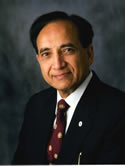| Abstract: |
Introduction. The relative rarity of mucosal melanomas of the head and neck (MMHN) has made analysis of treatment approaches difficult. Advances in diagnostic techniques and treatment interventions have had obvious impact on outcomes in cutaneous melanoma, but the effects on outcome in MMHN remain undefined. This study aims to assess the outcome and identify clinical and histologic prognostic indicators in a recent cohort of patients with MMHN treated at a single institution. Methods. The clinical records of 59 patients with the diagnosis of MMHN treated at Memorial Sloan-Kettering Cancer Center (MSKCC) between 1978 and 1998 were retrospectively reviewed. Pathologic material on each of these patients was prospectively reviewed by at least two pathologists (MP, KB, or AH) for confirmation of diagnosis and assessment of histologic variables. Survival was calculated by the Kaplan-Meier method. Clinical (patient demographics, tumor characteristics, and treatment) and histologic data (tumor thickness, melanosis, melanoma in situ, vascular invasion, and multifocality) were analyzed for impact on outcome by both univariate and multivariate analyses. Results. Thirty-five patients (59%) had sinonasal tumors (SNMM), whereas 24 (41%) had oral (ORMM) tumors. Forty-seven patients (79.6%) were staged as stage I, 8 (13.6%) as stage II, and 4 (6.8%) were classified as stage III. Regional lymphatic metastases at presentation were more frequent in ORMM compared with SNMM (25% vs 6%, p = .05). Surgery was used in all patients. Adjuvant radiation therapy was used more frequently in the SNMM group compared with the ORMM group (40% vs 17%, p = .04). The rates of local failure for ORMM and SNMM were 51% and 50%, nodal failure rates were 42% and 20%, and distant failure rates were 67% and 40%, respectively (p = NS). With a median follow-up of 20 months, the 5-year disease-specific survival rate was 44% (40% for ORMM vs 47% for SNMM, p = NS). Significant prognostic factors for disease-specific survival on univariate analysis included advanced clinical stage at presentation, tumor thickness greater than 5 mm, presence of vascular invasion, and development of nodal and distant metastases. On multivariate analysis, however, regional nodal failure lost significance. Conclusions. Clinical stage at presentation, tumor thickness greater than 5 mm, vascular invasion on histologic studies, and development of distant failure are the only independent predictors of outcome in MMHN. © 2002 Wiley Periodicals, Inc. |










